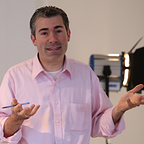Digital for Good
I’m very excited to share some news! My new book Digital for Good: Raising Kids to Thrive in an Online World (HBR Press) is now available. I wrote this book because I’ve become increasingly concerned with how we are preparing (or not preparing) young people to be successful in a digital world. While I’ve spent my career at the intersection of education and technology, the driving force behind writing the book came mostly from trying to help my 4 kids (between the ages of 8 and16) build healthy habits around their use of technology. Most of the books and websites my wife and I turned to seem to be more focused on scaring us with the dangers of technology without providing any useful strategies to help our family learn to use technology in healthy ways. The strategy of “don’t let your kids use technology until they’re 18” didn’t fit our family culture. Not only was that just not feasible in a post-COVID world, but everything I know from a career in education told me that learning to make good decisions required more practice and scaffolding, not less.
About 3 years ago I began seriously researching and interviewing parents, educators and technology experts about how they were teaching digital wellbeing in our homes and schools. Two consistent themes came up in almost every conversion.
First, our discussions with kids about their technology use are predominantly negative (don’t be mean, don’t look at things that are bad, don’t post something you’ll regret, don’t play that game so much, etc). While it’s true that there are many risks we should alert our kids to, becoming a healthy digital citizen requires more than telling them what not to do. You can’t practice not doing something! When it comes to creating a healthy balance, we need to be talking about the “dos” as much as the “don’ts”.
Second, our discussions with kids about their technology use overwhelmingly focus on online safety at the expense of other really important conversations. Don’t misunderstand me, staying safe online is critical. But teaching online safety can’t crowd out more meaningful conversations, like what type of person we want to be online and how we can use technology to make our communities better. Just like putting on a seatbelt when you drive a car — we teach our kids that it is a requirement before anything else happens. But the majority of our time and energy is spent thinking about where we want to go and who we want to go with. When it comes to creating a healthy digital culture, we need to be talking about using technology for good purposes in addition to being safe while we’re doing it.
Fortunately, in my research I also uncovered some really great practical strategies to help us find digital balance in our homes and prepare our kids to be better humans in a virtual world. These strategies are all shared in the book. They include topics like:
- Recognizing digital dysfunction
- Helping kids choose the best online activities
- Setting reasonable expectations for device use
- Finding the right balance between digital and physical activities
- Keeping stay safe and create safe spaces for others online
- Learning to spot false information online
The book is available today on Amazon, Barnes & Noble, and independent booksellers across the country. I believe the ideas in the book will help our future leaders become balanced, informed, inclusive, alert, and engaged members of the digital world. I hope you will join me!
